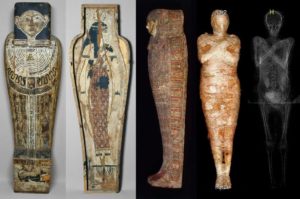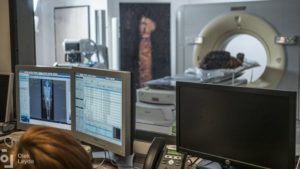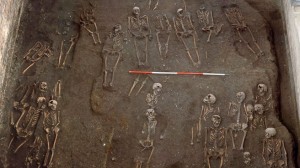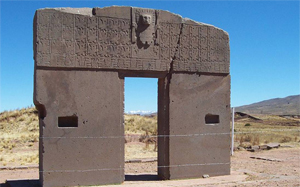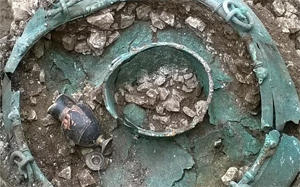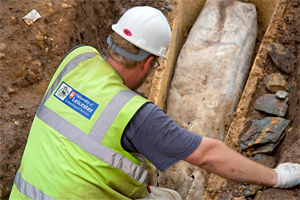Pregnant Egyptian mummy revealed by scientists
The discovery was made by researchers at the Warsaw Mummy Project and revealed in the Journal of Archaeological Science on Thursday.
The project, started in 2015, uses technology to examine artefacts housed at the National Museum in Warsaw.
The mummy was previously thought to be a male priest but scans reveal it was a woman in the later stages of pregnancy.
Experts from the project believe the remains are most likely of a high-status woman, aged between 20 and 30, who died during the 1st Century BC.
“Presented here is the only known example of a mummified pregnant woman and the first radiological images of such a foetus,” they wrote in the journal article announcing the find.
“This is our most important and most significant finding so far, a total surprise,” team member Wojciech Ejsmond of the Polish Academy of Sciences told the Associated Press.
Four bundles, thought to be wrapped and embalmed organs, were found within the mummy’s abdominal cavity but scientists say the foetus had not been removed from the uterus.
- Mummified animals ‘digitally unwrapped’
- Egyptian mummification ‘recipe’ revealed
- Egypt mummies pass through Cairo parade
The scientists said it was unclear why it had not been extracted and embalmed separately, but speculated spiritual beliefs about the afterlife or physical difficulties with removal may have contributed.
Archaeologists discovered one of Britain’s main medieval graveyards
Archaeologists found the human remains during a dig beneath an old school building at Cambridge University – one of England’s oldest and most impressive universities.
Images from the dig, viewing almost fully preserved medieval bodies unearthed after centuries of burial, were released for the first time yesterday, in a report published by the Archaeological Journal.
The report exposed the complete skeletal remains of more than 400 medieval burials were uncovered by the team, along with the incomplete remains of around 1000 other individuals.
The shocking images show the bodies tidily laid out in rows, without coffins or many personal items.Cambridge archaeologists say the skeletons, which date back to somewhere between the 13th and 15th century, were found while digging beneath the Old Divinity School at St John’s College.
The school, built in the late 1870s, was the past site of the St John the Evangelist Hospital’s committal ground, which was established in 1195 to care for to poor and sick.
Researchers say the lack of coffins and individual items supports the theory the graveyard was used to serve the poor.
The site also had gravel paths, a water well and flower seeds, suggesting that relatives had visited their deceased loved ones.
Craig Cessford of the Cambridge University Department of Archaeology and Anthropology led the dig and said it was “one of the main medieval hospital osteoarchaeological assemblages from the British Isles.”
The cemetery’s survival and location was no secret.
What historians didn’t know was just how many burials stood on the site. The sheer scope of the graveyard has been unknown until now.
Despite rumors linking the hospital graveyard to the Black Death and the plague, there was no evidence of disease on the remains, archaeologists said.
Most of the leftovers belonged to men aged between 25 and 45.
The bodies astonishingly did not display many serious illnesses and conditions that would have required medical attention.The Archaeological Journal report suggests that “this could reflect that the main role of the Hospital was religious and physical care of the poor and infirm rather than medical treatment of the sick and injured”.
Archaeologists discovered Underground Pyramid at Tiahuanaco
The ancient fortress site of Tiahuanaco in western Bolivia is still itself revealing secrets thousands of years after its peak as capital of an empire, and home to one of the most important civilizations prior to the Inca. Archaeologists from the Tiahuanaco Archeological Research Center have found an underground pyramid at the site using ground-penetrating radar.
According to Fox News Latino, the Bolivian government has announced excavations are set to start in this summer on the new find at the Kantatallita area of Tiahuanaco, 71 kilometers west of La Paz.
Using ground-penetrating radar, researchers also have reportedly invented “underground anomalies” which they suspect might be monoliths, but further analysis will be carried out before getting official conclusions.
Tiahuanaco Archeological Research Center director Ludwing Cayo, told EFE News Agency that Tiahuanaco will be undergoing further studies over the next five years. This is welcome news to some, as the site and stone monuments may have suffered from get in touch with weathering 4,000 meters over sea level.
AcercandoNaciones reports that some of the remains of Tiahunaco have become dilapidated, and some researchers advise these might advantage from the protection of an indoor museum.
Tiahuanaco has been a UNESCO World Heritage Site since 2000.
It was the capital of an empire that extended into present-day Peru and Chile, victorious from 300 to 1000 A.D., and is supposed to be one of the most significant cities of ancient America. Andean legends claim the area about Lake Titicaca was the cradle of the first humans on Earth. According to the myths, Lord Viracocha, the creator of all things, chose Tiahuanaco as the place of formation. It is unknown how old these remains are, but some researchers suggest that they date to 14,000 years B.C.
Fox News Latino writes that at its height, the Tiwanaku realm covered 600,000 square kilometers and “left a legacy of exciting stone monuments such as Kalasasaya, the semi-underground Templete, sculptures of famous figures, the Gate of the Sun and ruins of palaces.
Earlier excavations at the site have uncovered substantial portions of the Akapana Pyramid Mound.
Archaeology’s InteractiveDig writes that in the ancient past there is proof that the recognized transportation was razed and recreated by the inhabitants, and the city was abandoned. Researchers say there was an unexpected shift in 700 A.D. earlier monuments were torn down, and the blocks were used to put up the Akapana Pyramid. However, by the time the city was abandoned, the project had still not been completed, and laid unfinished.
Results from the excavations at Tiahuanaco and the research into the recently detected hidden pyramid are expected to be announced later this year.
Ancient Cauldron Discovered Inside The Tomb Of Celtic Prince In France
France’s National Archaeological Research Institute discovered an ancient grave site, from probably that of an Iron Age Celtic prince, which may lead to the trade between some of Europe’s earliest civilizations.
Since October last year a team from the institute has been excavating the site, and have dated it to the end of the First Iron Age a period characterized by the wide use of the metal.
The ‘exceptional’ grave, crowded with Greek and possibly Etruscan artifacts’, was exposed in a business zone on the outskirts of Lavau in France’s Champagne region.
This prince is covered with his chariot at the centre of a huge mound, 130 feet (40 metres) across, which has been dated to the 5th Century BC. A team from the National Archaeological Research Institute, Inrap has been excavating the site since October last year.They newly dated it to the end of the First Iron Age – a period characterised by the widespread use of the metal. Its discovery could shed light on Iron Age European trade, researchers say.
The 2,500-year-old funeral mound has at its heart a 14 square metre burial chamber, not yet opened, of an early royal.
The cauldron discovered in the grave has four circular handles decorated with bronze heads that shows the Greek god Acheloos.
The river divinity is shown with horns, a beard, the ears of a bull and a triple mustache. Eight lioness heads decorate the edge of the cauldron. This tomb enclosed a decorated ceramic wine pitcher made by the Greeks.
The decorations on the vessel reveals the god Dionysus, lying under a vine and facing a woman. The archaeologists also found leftovers of a iron wheel, from a chariot buried with the prince. Another interesting detection was a perforated silver spoon that was part of the banquet utensils, presumably to filter the wine.
Archaeologists found a strange mystery coffin near King Richard III’s grave
Archaeologists found a strange lead coffin close to King Richard III’s grave beneath a parking lot in Leicester, England, enclosed the skeleton of an elderly woman.
The Featuring an inlaid crucifix, cautiously soldered on all sides but with feet sticking out of the bottom, the lead coffin was found inside a larger limestone sarcophagus. The finding came one year after the battle-scarred leftovers of the last Plantagenet king of England. The family ruled enormous areas of Europe were unearthed.
The lady in the lead casket might have died as late as 1400, although it’s much more likely she was obscured ahead of Richard III’s death at the Battle of Bosworth.
But her tomb was the first intact medieval stone coffin unearthed in the area, it wasn’t the only grave found at the site. Nine other burials were recognized under the car park, which was basically the site of Grey Friars Church, the medieval friary of the Franciscans known to have been Richard III’s final resting place.
They said she must have been of a high status, because her bones show signs of a lifetime of eating well. She’s also not the only woman buried on the grounds of Grey Friars. In fact, Richard III is the only man archaeologists have examined from the site so far. They four other graves, including the lead coffin, belonged to women the discovery of four female burials came as somewhat of a surprise. Archaeologists said.
Richard III ruled England from 1483 until he was killed on the battlefield in the Wars of the Roses in 1485. As his rival, Henry Tudor, ascended the throne, Richard received a quick burial at the Grey Friars monastery, which was demolished in the 16th century during the Protestant Reformation.
Grey Friars’ accurate location was lost to history. In 2012, archaeologists with the University of Leicester discovered the remains of the monastery as well as Richard’s long-lost grave below a parking lot.
Much of the hype around the dig has centered on Richard, and his remains have already yielded a wealth of data on the king he died in a violent death; he ate quite well while on the throne; and he suffered from scoliosis. But archaeologists have also been studying whatever else they can find in the church.
Inside the friary’s choir where Richard III was found found two other women between ages 40 and 50 were found buried in wooden coffins Radiocarbon dating showed that they likely died between 1270 and 1400. One of the women had a hip problem that forced her to walk with a crutch, and the other women seems to have used her arms and legs frequently to lift heavy weights, suggesting a life of hard physical labor, the researchers said.
Most other monastic cemeteries in England have female-male burial ratios ranging from 1 female for every 3 males to 1 female for every 20 males, Morris said. The excavators don’t know exactly what to make of all the female burials at Grey Friars, and they were cautious about drawing any broad conclusions based on this small sample. The archaeologists recognized but didn’t examine five other burial pits on the site, and they thinks these burials were just a fraction of the total graves on the church grounds.
However, it’s believed that archaeologists will unearth more of the graves at Grey Friars any time soon.
